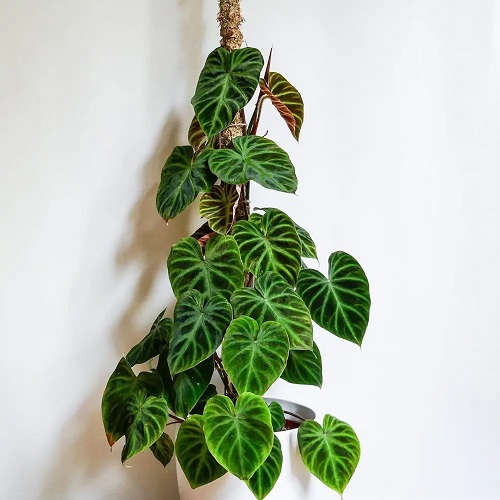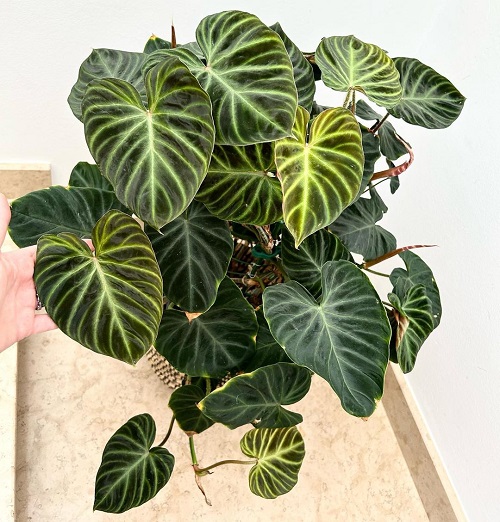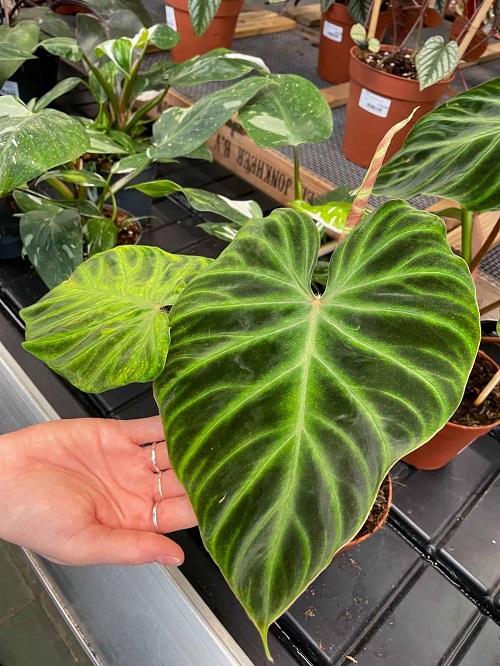Have a look at the comprehensive Philodendron Verrucosum Care guide that will help you grow this beautiful easily!

The Ecuador Philodendron is a stunning tropical houseplant known for its large, glossy leaves and ease of care. This Philodendron Verrucosum Care guide provides all the right tips and tricks.
Here are the Best Colourful Philodendron Varieties
Ecucador Philodendron Plant Information
The Ecuador Philodendron is a species of epiphytic, evergreen perennial native to the tropical rainforests of South America. It is prized for its large, glossy leaves that are typically deep green in color and can grow up to 2 feet long. The leaves are oval or elliptical in shape and have a leathery texture.
The Philodendron Verrucosum is a low-maintenance plant that is well-suited for growing indoors as a houseplant. It is a fast grower and can become large if given proper care and conditions. When grown in ideal conditions, the Ecuador Philodendron can produce long aerial roots and may also produce aerial shoots, which can be propagated to produce new plants.
Learn about Growing Philodendron cordatum here
How to Propagate Philodendron Verrucosum
The Ecuador Philodendron can be propagated through the division of aerial roots, stem cuttings, or by rooting aerial shoots.
- Division of Aerial Roots: Once the plant has produced long aerial roots, it can be carefully removed from its pot, and the root ball is divided into smaller sections, each with a healthy root system. These sections can then be planted in their own pots with fresh potting soil.
- Stem Cuttings: Cut a stem section with a couple of leaves on it, and remove the lower leaves. Dip the cut end in rooting hormone powder and plant it in a moist growing medium, such as perlite or sand. Keep the cuttings in a warm, bright place with high humidity until they have rooted and developed new growth.
- Rooting Aerial Shoots: When the Ecuador Philodendron produces aerial shoots, they can be gently removed and placed in a glass of water. Once roots have developed, they can be planted in a moist growing medium.
In all cases, it’s important to provide the newly propagated plants with bright, indirect light, good humidity, and well-draining soil to ensure their success.
Learn the Pink Princess Philodendron Care Tips Here
Requirements for Growing Ecuador Philodendron

Location
The Ecuador Philodendron thrives in bright, indirect light and warm, humid environments with temperatures between 65-85°F (18-29°C). Avoid direct sunlight. Ideal for indoor growing near a bright east or west-facing window.
Soil
The ideal soil for the Ecuador Philodendron is well-draining with high organic matter, such as a mixture of peat moss, perlite, and vermiculite.
Water
Water Philodendron Verrucosum regularly to keep the soil moist, but be careful not to over-water as this can lead to root rot. It is best to allow the top inch of soil to dry out before watering again.
Temperature and Humidity
Philodendron Verrucosum prefers warm, humid conditions with temperatures between 65-85°F (18-29°C).
The plant thrives in high humidity, so it is best to keep it in a humid environment or mist it regularly to increase humidity.
Check out the best Indoor Philodendron Varieties that you can grow here
Philodendron Verrucosum Care

Fertilizer
The best fertilizer for Philodendron Verrucosum is a balanced, water-soluble one with an equal ratio of nitrogen, phosphorus, and potassium. A 20-20-20 fertilizer is a good choice.
We recommend using a liquid fertilizer at half the recommended strength once a month during the growing season. If using a slow-release fertilizer, apply it every two to three months. Always water your Philodendron after fertilizing.
Pests and Diseases
Pests:
-Aphids
-Mealybugs
-Fungus Gnats
-Scale
-Spider Mites
Diseases:
-Pythium Root Rot
-Botrytis Blight
-Fusarium Wilt
-Crown Rot
-Powdery Mildew
For pests, use an insecticidal soap or a neem oil solution when you spot them. To keep most of the diseases at bay, provide plenty of dappled light and air circulation. Also, do not overwater and wet the foliage.

